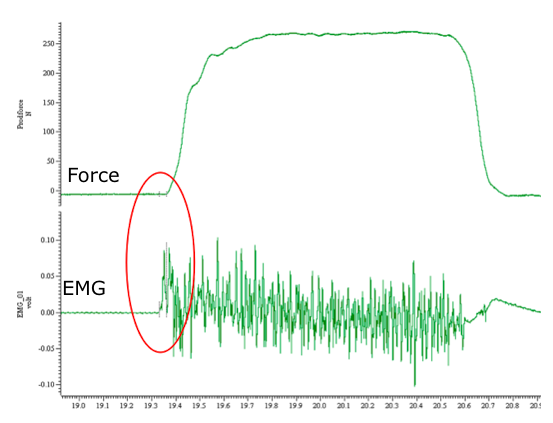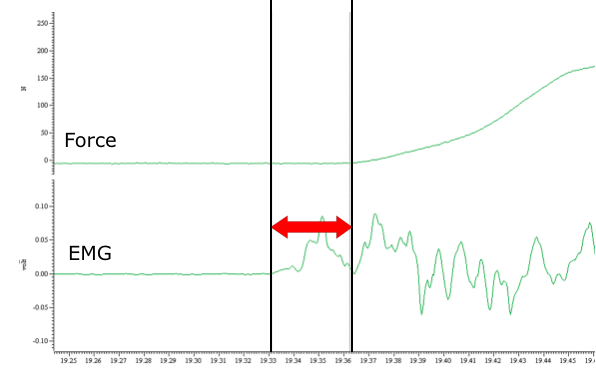So, we’re in week 9 of Strength & Conditioning for physiotherapists and so far, we’ve been focussing principally on muscle strength, so I’ve decided to change it up a bit.
Whilst muscle strength is fundamentally important to rehabilitation, recovery, performance, determining extent of adaptations of other parameters etc., other indices of muscle function can be equally important … possibly more so in certain circumstances.
It’s pleasing to see in the mainstream rehabilitation literature now citations of, and references to rate of force development (RFD), which can broadly be termed ‘muscle power’ in functional settings – essentially the speed of muscle force production. However, there’s another index of muscle performance that we need to consider, determined by physiologic events that happen even before we start to register muscle force production
Electromechanical Delay
What is electromechanical delay, or EMD for short? EMD is:
The time delay between the onset of muscle EMG and the onset of muscle force production.
That’s right, there’s a delay at the muscle site from when the electrical activity happens – i.e. has received the signal to contract, to the start of the production of muscle force. Look at the figure below. This is a data trace from my lab during a maximal isometric contraction of the quadriceps muscles, with electrodes to detect EMG placed on the vastus laterals. It looks like the EMG and the force start at the same time….that would make sense, right?

Well, now look at what happens if we zoom into the area highlighted by the red oval – see below.

This delay, the EMD becomes clear – highlighted here by the red arrow. The EMD in healthy, fit young males for the quadriceps, measured under isometric conditions is usually around the 25-35 ms mark. Doesn’t sound very long does it? There are 1000 ms in 1 second. So why are we concerned with this index?
The Relevance of Electromechanical Delay
EMD is changeable. It responds to detraining, injury and fatigue and can increase by several fold, it also increases with ageing. Certainly I’ve seen figures of in excess of 100+ ms in rehabilitating and injured populations. Refer to the literature and you’ll see a similar thing (some references below if you want to read more 1-4). What does this mean? well, relate to the EMD as the ‘switch on times’ of the musculature. If it takes a lot longer to switch the muscles on, the delay in producing muscle force is delayed, thus from a joint stabilisation perspective, the ability to rapidly harness dynamic joint forces is also delayed. Likewise, consider an agonist-antagonist muscle pair, it could be that prolonged switch on times of the hamstrings muscles relative to the quadriceps may render the knee more prone to ACL injury by permitting unrestrained anterior tibia translation (1).
So, within the current theoretical models of joint stability and injury risk, a long EMD might constitute an increase risk of injury, whether that be the elite athlete needing to respond to rapidly imposed high-force dynamic loads associated with match play, or the older person who stumbles whilst getting out of a chair and needs to avoid a fall.
Is EMD Trainable?
In short, yes. Phew! Like any index of neuromuscular performance (strength, RFD, sensorimotor performance etc.), apply the right stimulus [remember specificity of training from the first post in this series?] and adaptation can occur. However, we need to understand the determinants of EMD such that we can do this.
The Physiologic Events Associated with EMD
So, what’s going on in this delay? EMD is broadly driven by two factors, the propagation of the action potential through the muscle and the stretch of the series elastic component. Basically this means the time it takes to send the ‘signal to contract’ through the muscle and then the time it takes to reel in the compliant tissue, such as the tendon and tendon aponeurosis, so that muscle force can be applied to the bone.
I like to explain it like a car towing another car. The car in front needs to start the engine and then take up the slack in the tow rope before the car behind it can move.

Fast Twitch Muscles are Faster
D’ho, really? Daft statement, I know, but we know from the literature that ‘fast twitch’ muscles generally have quicker EMDs than ‘slower twitch’ muscles. If we apply this to training or rehab, it would make sense, therefore, if we could increase the fast twitch capacity of a muscle, the initial motor unit discharge rate, synchrony of firing etc, then this may positively influence EMD.
Also, don’t forget compliance, which is another moderating factor of EMD. In theory if we increased musculotendionous stiffness, it would mean less time is spent stretching and ‘reeling in’ connective tissue and thus result in a quicker transmission of muscle force to bone – i.e. a quicker EMD.
All this is theoretical, but next week I’ll focus on application of theory to practice – how to focus your rehabilitation and conditioning interventions to train electromechanical delay.
A Final Note
A common misconception about EMD is that it’s influenced by information processing – how quickly you can respond to a visual or auditory stimulus. Whilst EMD is a component of total reaction time, for example how quickly a sprinter can get out of the blocks after hearing the gun, EMD is not driven by any cognitive function or processing. This delay, the EMD occurs at the muscle site and is determined by local processes, therefore, this is where we will focus our conditioning… next week 🙂
IT’S HERE! Download your Free 14-page guide: Strength & Conditioning for Therapists
References:
- Hannah, Minshull et. al. (2014). Longer Electromechanical Delay Impairs Hamstrings Explosive Force versus Quadriceps. Med. Sci. Sports Exerc. 46 (5), 963–972
- Minshull, Eston et al. (2011). Repeated exercise stress impairs volitional but not magnetically evoked electromechanical delay of the knee flexors. J Sports Sciences 30(2):217-25.
- Nordez, Gallot et al. (2009) Electromechanical delay revisited using very high frame rate ultrasound. J Appl Physiol 106: 1970–1975;
- Longo et al. (2017). Correlation between stiffness and electromechanical delay components during muscle contraction and relaxation before and after static stretching. J Electromyogr Kinesiol. 33: 83-93
